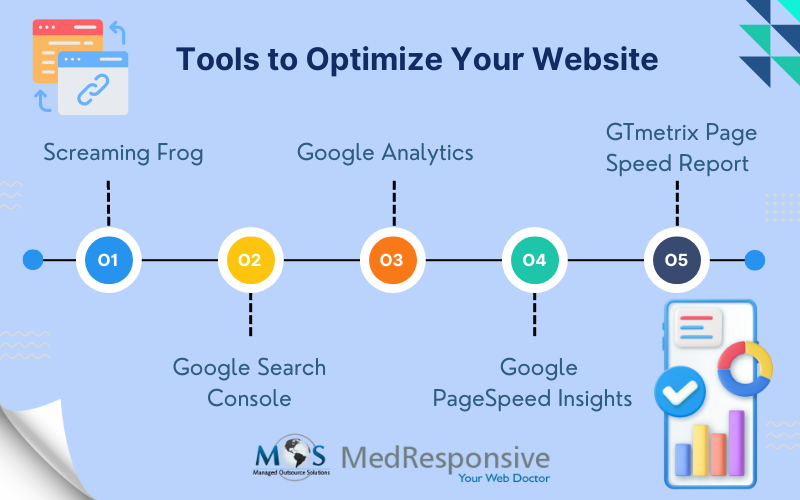In order to optimize a website and increase its visibility on search engine result pages, technical SEO tools are essential. These tools give businesses useful information about the technical functioning of their website, allowing them to find and address problems that might be affecting their search engine rankings.
Specialists in an experienced SEO outsourcing company examine a website’s structure, find problems like broken links, duplicate content, or missing meta tags, and enhance mobile optimization using sophisticated technical SEO tools. SEO experts make sure that business websites are optimized for both search engines and users by using these tools to find and fix technical issues. This can improve website speed, security, and navigability and increase traffic, engagement, and conversions.
5 Top Tools to Optimize Your Website
Screaming Frog
Manually checking every page on large websites is labor-intensive, and there is an increased risk of overlooking crucial problems like duplicate pages, meta refreshes, and redirects. Screaming Frog is a sophisticated SEO site audit tool that can swiftly crawl both small and large websites. It finds technical problems and suggests fixes to raise your website’s search engine rankings. Its user interface automatically collects and updates crawl data, making it simple to view, analyze, and filter the information. Key on-site SEO components (URL, page title, meta description, headings, etc.) can be exported to a spreadsheet for convenient use as the foundation for SEO recommendations.
Using Screaming Frog involves the following steps:
- To configure the crawl, select “Configuration.”
- Visit the “Internal” tab to view crawl data.
- Check the “overview” tab on the right-hand window for mistakes and problems.
- Export all of the crawl’s data into spreadsheets.
Google Search Console
This free tool from Google lets you manage your website’s online presence, troubleshoot technical SEO issues, track and improve your website’s SEO performance, and improve rankings. It helps find and diagnose technical problems that can impact visibility and ranking, and provides insightful information about how well a website is performing.
Using this tool involves the following steps:
- Verify who owns the site
- Examine the report on Index coverage
- Examine mobile usability issues
- Submit a sitemap to Search Console
- Keep an eye on the site’s functionality
The amount of traffic you receive from Google Search is displayed in the Search Performance Report, along with breakdowns by queries, pages, and nations. It displays crucial data such as which queries are made on mobile devices, how your search traffic fluctuates over time, and which pages from Google search results have the highest (and lowest) click-through rates.
Google Analytics
With Google Analytics, you can track website traffic, keep an eye on website speed, and gain insights into crawlability, mistakes, and mobile traffic.
Technical SEO outcomes are measured by Google Analytics through
- Establishing a personalized Google Analytics dashboard
- Producing personalized reports depending on business-specific metrics
- Data filtration based on organic traffic
- Monitoring demographic interests
- Generating reports on assisted conversion
Resolving technical SEO problems enhances user experience and raises search engine rankings for your website.
Google PageSpeed Insights
The free tool PageSpeed Insights (PSI) provides reports that assess a webpage’s user experience on desktop and mobile platforms. It offers recommendations regarding how to make the page better to improve the user experience.
Users of Google’s PSI tool can click Analyze after entering any URL into the toolbar. Two kinds of information are gathered in order to assess a page’s effectiveness. Real-world performance information about the page can be gleaned from field data taken from the Chrome User Experience Report (CrUX). “Lab Data” is the term for the second category of data gathered through the Lighthouse API. Using a mid-tier device and mobile networks, this kind of data assesses the page’s performance and speed in a controlled, simulated environment. It is beneficial to remove some of the factors that could affect the functionality and speed of a page.
Website owners and developers can pinpoint areas where their pages need to be improved by examining PSI reports. The reports provide information on time to interactive, page load speed, and other important metrics. The suggestions made by PSI can aid in image optimization, resource reduction that prevents render-blocking, and enhanced caching.
Explore the key factors that can significantly impact your web page speed in our blog post: Key Factors That Affect Your Web Page Speed
GTmetrix Page Speed Report
GTmetrix is a page speed analysis tool that looks for ways to improve website performance and offers suggestions for speeding up slow pages.
It enables testing of pages on more than thirty different Simulated Device options, or on an actual Android device. Users can track a site’s load time, size, and number of requests, among other performance metrics, and generate a score and recommendations to improve the site’s performance.
Additionally, GTmetrix offers a performance report that provides the following information:
- The speed index measures how long it takes for a page’s contents to be visible.
- Time to Interactive: A gauge of how responsive a load is
- First contentful paint: To gauge how long it takes for users to view the text, photos, and videos on the website
This tool assesses the functionality of the website and pinpoints areas that can be improved for optimal performance and user experience. GTmetrix has several tabs, including performance tab, structure tab, waterfall tab, video tab, and history tab.
Businesses can use these technological tools to further their SEO marketing efforts by collaborating with expert digital marketing services. These tools can improve results with little work, whether it’s creating engaging content or masterfully optimizing a website’s SEO.
Optimize, Analyze, and Dominate Search Results
Increase conversions by harnessing the power of proven technical SEO tools tailored to your website’s needs.





